Abstract
At the echelons of children and youth, physical training is the support on which to build other factors sports training prerequisite for achieving superior performance in old Senior career. Specific physical preparation, seeks improvement skills needed to meet the growing demands of the current handball in terms of driving dynamics and structures effort specific phases of attack and defense. This research was conducted within a team handball performance participating in the National Championship Division on a group of 16 female athletes tested at the beginning and end of the competition, during which operated a number of specific means specific physical preparation, selected and dosed according to age peculiarities and preparation of subjects. The results recorded in the control samples were processed and interpreted to identify statistical and mathematical progress rate and deducing some conclusions from experimental research. In this regard, a number of indicators were statistical and mathematical science specific to the sport and physical education, such as arithmetic mean, standard deviation, coefficient of variation and test ,,t" test that indicates materiality of progress. Research methods used during the research were specific to physical education and sports training, namely: studying literature, teaching observation, experimental method, method of control tests and trials, the experimental method and graphical method.
Keywords: Experimenthandballtrainingperformance
Introduction
For sports games in general and for the game of handball, especially physical training is the base,
you can build other factors sports training (technical training, tactical, psychological etc.). At the level
handball teams performance, specific physical preparation is what makes the difference in obtaining
valuable results, the issue of specialization training being widely debated and considered factor, so they
are always looking for new ways and means to contribute as directly optimize athletic performance.
Research methods applied during the research were specific to physical education and sport
science with high applicability in such type of research. In this regard they were used: the study of
literature - the works of Romanian and foreign specialists focused on sports training in general and
training of sports in handball, in particular, and a series of works interdisciplinary meant to substantiate
the theoretical and experimental research; pedagogical remark - made during training lessons in subjects
of research, but also to other handball team performance and observation at a number of games conducted
at all levels handball performance; statistical and mathematical method - through the industry-specific
indicators such as arithmetic mean, standard deviation, coefficient of variation and test ,,t"; Method
educational experiment - conducted during competition for the target group was driven by a number of
means selected and customized specific objectives, the results are evaluated by the control samples
developed specialized federation; graphical method to represent specific drives handball and research
results in order to better views.
Hypothesis
We believe that if a team handball performance we use in preparing a series of drive means
selected and dosed in accordance with the structure of handball motor current, then the indices specific
physical preparation will experience higher values.
Experiment
In order to confirm the hypothesis research was conducted during a pedagogical experiment on
returning to competition National Championship Women Division ,,A" team when the components have
come a supplementary program for improvement of specific physical preparation. In this respect, the
drives have been tested in practice coded free survival and numbered following the experiment runs
weekly training cycle to be completed additional training focused on three specific physical preparation
indices increase. The number of repeats, the length and nature of each of the drives breaks were different
depending on the reaction to the efforts of the athletes.
Results
In order to verify the initial level of physical preparation specific indices were selected out five
control samples developed specialized federation as follows: Speed running on the distance of 30 meters
with standing start; travel triangle, three complete tracks roundtrip; handball throwing away the
momentum of three steps; among huge milestones on the distance of 30 meters, seven benchmarks;
sample specific.
The degree of progress by the research subjects, upon actuation of the means selected and dosed to
optimize indices specific physical preparation was evaluated after final testing, in which they again
passed the same tests and control tests.
Test values "t" calculated from the test results of the initial and final testing of the group of
subjects in order to verify the significance between the medium and safety compared to that of "t" of the
table the number of times of Fischer n-2, which is 2.921 materiality of p<0.01 are shown in table
Discussions
The control sample running speed on the distance of 30 m with standing start record in the initial
testing of the arithmetic average value of 5.23 seconds with a standard deviation of 0.33 seconds -
misconduct that falls within the normal range - over 68%, and a coefficient of variation value of 6.45% -
higher degree of homogeneity (0-10%). At the final testing there is an arithmetic mean value of 5.02
seconds with a higher initial testing progress by 0.21 standard deviation 0.27 seconds - less than in the
initial testing and within normal limits. The coefficient of variation indicates a trend towards improved
homogeneity of the group value 6.45% to 5.47% (both values in high homogeneity threshold), while the
value test "t" calculated between performances of initial testing of the target group and the final test of
9.381 and compared with that of "t" of a Fischer table corresponding to the number of cases in the column
n-2 or 18-2 = 16 for the 0.01 significance threshold value of 2.921 indicates that the differences are
significant with a 99% reliability, risk of error 1% (p <0.01).
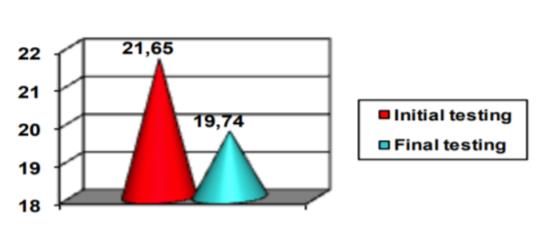
The control sample displacement triangle initial testing is the arithmetic mean value of 21.65
seconds with a standard deviation of 1.14 seconds - normal and a coefficient of variation value of 5.29% - high homogeneity (0 -10%). Final testing is the arithmetic mean value of 19.74 seconds, with a top initial
testing progress by 1.91 seconds, standard deviation 1.07 seconds - less than in the initial testing and
within normal limits. The coefficient of variation indicates a downward trend in group homogeneity value
being 5.46% (both values in high homogeneity threshold), while the value test "t" calculated between the
performance of the target group at initial testing and testing end of 14.159 and compared to that of "t" of a Fischer table corresponding to the number of cases in the column n-2 or 18-2 = 16 for the 0.01
significance threshold with a value of 2.921 indicates that the difference are significant with a 99% reliability, risk of error 1% (p <0.01).
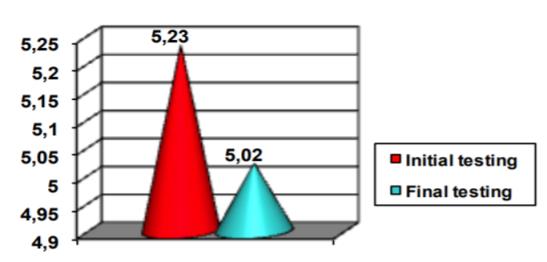
Throwing handball ball to distance initial testing indicates the arithmetic mean value of 33.08
meters with a standard deviation of 2.72 meters - normal and a coefficient of variation value of 8.23% -
high homogeneity (0-10%). Final testing is the arithmetic mean value of 33.94 meters, higher initial
testing with a progress of 0.86 meters, 2.63 meters standard deviation - lower than the initial testing and
within normal limits. The coefficient of variation indicates a downward trend in group homogeneity value
being 7.75% (both values in high homogeneity threshold), while the value test "t" calculated between the
performance of the target group at initial testing and testing end of 6.803 and compared with that of "t" of
a Fischer table corresponding to the number of cases in the column n-2 or 18-2 = 16 for the 0.01
significance threshold with a value of 2.921 indicates that the difference are significant with a 99%
reliability, risk of error 1% (p <0.01).
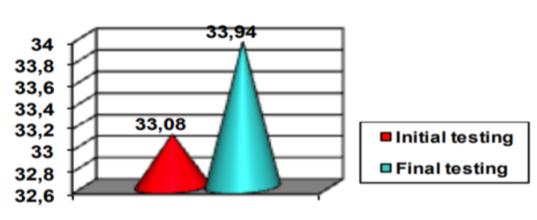
The control sample ball driving among cones initial testing is the arithmetic mean value of 8.14
seconds with a standard deviation of 0.69 seconds - normal and a coefficient of variation value of 8.48% - high homogeneity (0 -10%). Final testing is the arithmetic mean value of 7.53 seconds, with a top initial
testing progress by 0.61 seconds, standard deviation 0.60 seconds - less than in the initial testing and
within normal limits. The coefficient of variation indicates a downward trend in group homogeneity value
being 8.04% (both values in high homogeneity threshold), while the value test "t" calculated between the
performance of the target group at initial testing and testing end of 8.767 and compared with that of "t" of a Fischer table corresponding to the number of cases in the column n-2 or 18-2 = 16 for the 0.01
significance threshold with a value of 2.921 indicates that the difference are significant with a 99% reliability, risk of error 1% (p <0.01).
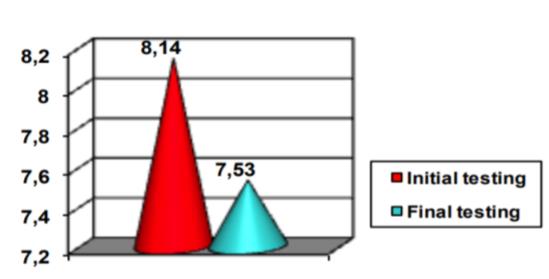
Specific sample initial testing indicates the arithmetic mean value of 51.65 seconds with a
standard deviation 1.99 seconds - normal and a coefficient of variation value of 3.86% - high
homogeneity (0-10 %). Final testing is the arithmetic mean value of 49.49 seconds, with a top initial
testing progress by 1.16 seconds, standard deviation 1.51 seconds - less than in the initial testing and
within normal limits. The coefficient of variation indicates a downward trend in group homogeneity value
being 3.06% (both values in high homogeneity threshold), while the value test "t" calculated between the
performance of the target group at initial testing and testing end of 12.301 and compared to that of "t" of a Fischer table corresponding to the number of cases in the column n-2 or 18-2 = 16 for the 0.01
significance threshold with a value of 2921 indicates that the difference are significant with a 99%
reliability, risk of error 1% (p <0.01).
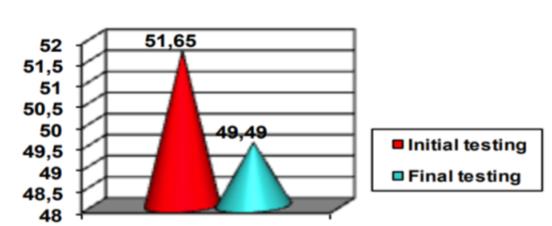
Conclusion
In the annual cycle of training, specific physical preparation is present in all stages and preparation
periods, but with different weights, proper work to optimize its being after the general physical
preparation.
The results obtained from research subjects in the initial testing and final fall within the federation
model developed for this specialized echelon of performance, but varied depending on the position of the
athletes play.
Arithmetic recorded higher values in all samples of control subjects in the final testing research,
which demonstrates the effectiveness of drives used during the research.
Test values "t" calculated from the results of research subjects and the final initial testing, we
present all control samples values above the table the number of cases of Fischer n-2 or 18-2 = 16
threshold significance 0.01 which demonstrates that the results of the tests are safety significance with a
99% risk of error 1% (p <0.01).
References
- Achim, Ş. (2015). Planificarea în pregătirea sportivă. CNFPA, 12-31, 55-64
- Bompa, T. (2003). Performanţa în jocurile sportive, Teoria şi metodologia antrenamentului. Ex Ponto, 63-77, 105-140
- Cunin, M. (2002). Pregătirea fizică a unui jucător de handbal. Cursul de perfecţionare al profesorilor şi antrenorilor din România cu specializarea handbal, 49-61
- Dragnea, A. (1984). Măsurarea şi evaluarea în educaţie fizică şi sport. Sport turism, 43-47
- Epuran, M. (2005). Metodologia cercetării activităţilor corporale. FEST, 245-247, 256-261
- Mihăilă, I. (2006). Handbal, Optimizarea pregătirii fizice specifice la echipele de juniori. Universitaria,
- Simion, G. &Mihăilă, I. & Stănculescu, G. (2011). Antrenament sportiv concept sistemic. Ovidius University Press, 118-121, 150-181
Copyright information

This work is licensed under a Creative Commons Attribution-NonCommercial-NoDerivatives 4.0 International License.
About this article
Publication Date
25 May 2017
Article Doi
eBook ISBN
978-1-80296-022-8
Publisher
Future Academy
Volume
23
Print ISBN (optional)
-
Edition Number
1st Edition
Pages
1-2032
Subjects
Educational strategies, educational policy, organization of education, management of education, teacher, teacher training
Cite this article as:
Mihăilă, I. (2017). Experimentation Exercises to Achieve Specific Physical Preparation Handball Teams to Performance. In E. Soare, & C. Langa (Eds.), Education Facing Contemporary World Issues, vol 23. European Proceedings of Social and Behavioural Sciences (pp. 1756-1762). Future Academy. https://doi.org/10.15405/epsbs.2017.05.02.215

